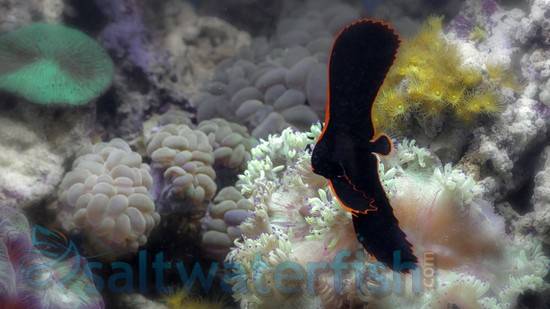Pinnatus Batfish – (Platax pinnatus)
Quick Stats:
- Care Level: Intermediate
- Temperament: Peaceful
- Diet: Omnivore
- Reef Safe: No
- Minimum Tank Size: 180 gallons
- Maximum Size: 16 inches
- Water Parameters: pH 8.1-8.4, Salinity 1.020-1.025, Temperature 72-78°F
Pinnatus Batfish – (Platax pinnatus): A Comprehensive Guide
The Pinnatus Batfish, also known as the Dusky Batfish or Red-faced Batfish, is a species commonly found in the Indo-Pacific region. It is a beautiful and fascinating fish that requires specific care in a saltwater aquarium.
Habitat
The Pinnatus Batfish is usually found in shallow coastal reefs and lagoons, often swimming in small schools. It prefers areas with sandy or muddy substrates where it can search for food.
Reef Safe
The Pinnatus Batfish is not considered reef safe due to its tendency to nip at corals and invertebrates. It should be kept in a fish-only or predator tank.
Size
The Pinnatus Batfish can grow up to 16 inches in length, making it a relatively large fish for a home aquarium. It requires a tank with ample swimming space.
Temperament
This species is generally peaceful and can be kept with other non-aggressive fish. However, it may become territorial towards its own species or other species of batfish.
Sexual Dimorphism
There are no significant external differences between males and females of the Pinnatus Batfish. It is difficult to determine the sex of this species without internal examination.
Lifespan
The Pinnatus Batfish has a lifespan of around 10-15 years in a well-maintained aquarium with proper care and nutrition.
Diet in Aquariums
This species is an omnivore and requires a varied diet. It should be fed a combination of high-quality pellets, frozen or live foods such as brine shrimp, mysis shrimp, and chopped seafood. It is important to provide a balanced diet to ensure its health and well-being.
Aquascaping Recommendations
The Pinnatus Batfish prefers a tank with ample swimming space and areas of sandy or muddy substrate for foraging. It will appreciate the presence of hiding spots created with rocks and coral formations.
Captive Bred Availability
The Pinnatus Batfish is not commonly available as a captive-bred species. Most individuals in the aquarium trade are wild-caught. It is important to source the fish from reputable and sustainable suppliers to minimize the impact on wild populations.
Compatibility with Other Fish, Invertebrates or Corals
The Pinnatus Batfish can be kept with other non-aggressive fish that are too large to be considered prey. It should not be kept with small fish or invertebrates that may be seen as food. Suitable tankmates include Lionfish, Groupers, Triggerfish, and larger Tangs. These species are compatible due to their similar size and temperament.
Other Common Names
The Pinnatus Batfish is also commonly known as the Dusky Batfish or Red-faced Batfish.
Why buy from Reefs4Less.com
Reefs4Less.com offers a wide range of high-quality saltwater aquarium fish and supplies. They prioritize the well-being of their aquatic life, ensuring they are sustainably sourced and properly cared for. Their experienced team provides excellent customer service and expert advice to help customers create and maintain successful saltwater aquariums.
Popular Questions and Answers
1. What is the ideal tank size for a Pinnatus Batfish?
The Pinnatus Batfish requires a minimum tank size of 180 gallons to provide enough swimming space and accommodate its potential size.
2. Can the Pinnatus Batfish be kept in a reef tank?
No, the Pinnatus Batfish is not reef safe as it may nip at corals and invertebrates. It is best kept in a fish-only or predator tank.
3. How often should the Pinnatus Batfish be fed?
It is recommended to feed the Pinnatus Batfish 2-3 times a day, offering a variety of high-quality pellets and frozen/live foods.
4. Can the Pinnatus Batfish be kept with smaller fish?
No, the Pinnatus Batfish may see smaller fish as prey and may try to consume them. It is best to avoid keeping it with smaller fish.
5. How long does the Pinnatus Batfish live?
The Pinnatus Batfish has a lifespan of around 10-15 years with proper care and a suitable environment.
| Size | < 2 inches |
|---|


Reviews
There are no reviews yet.